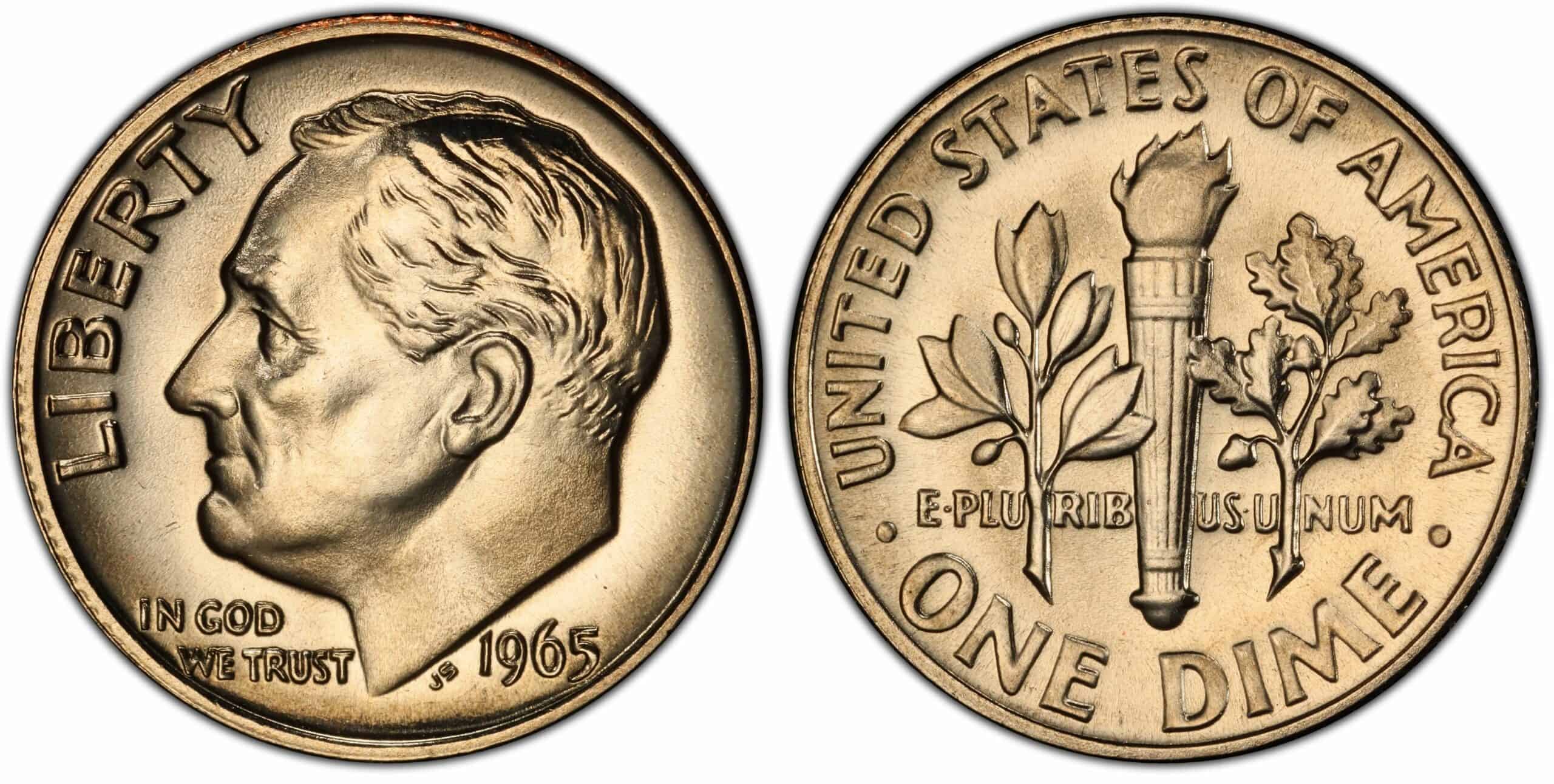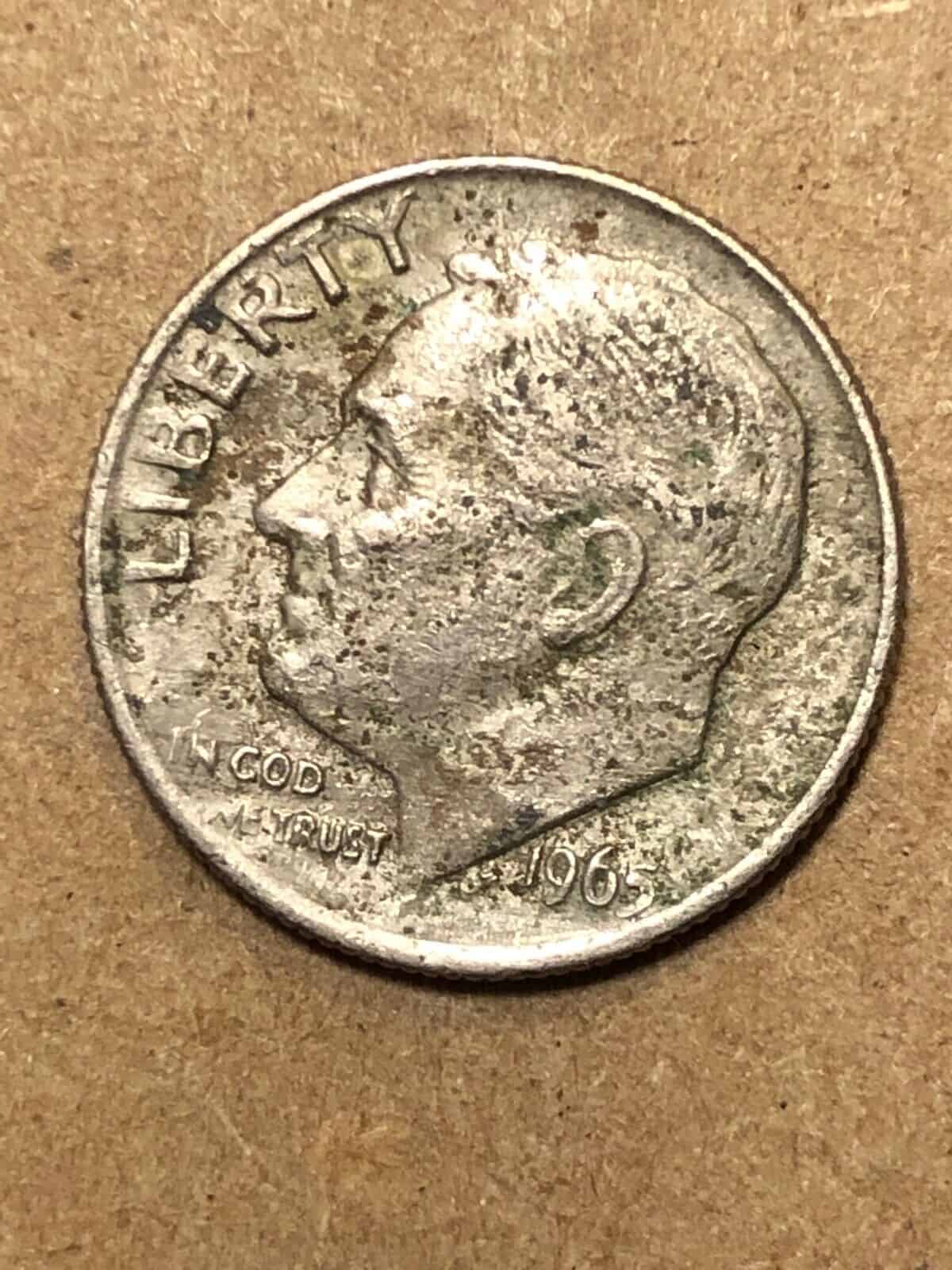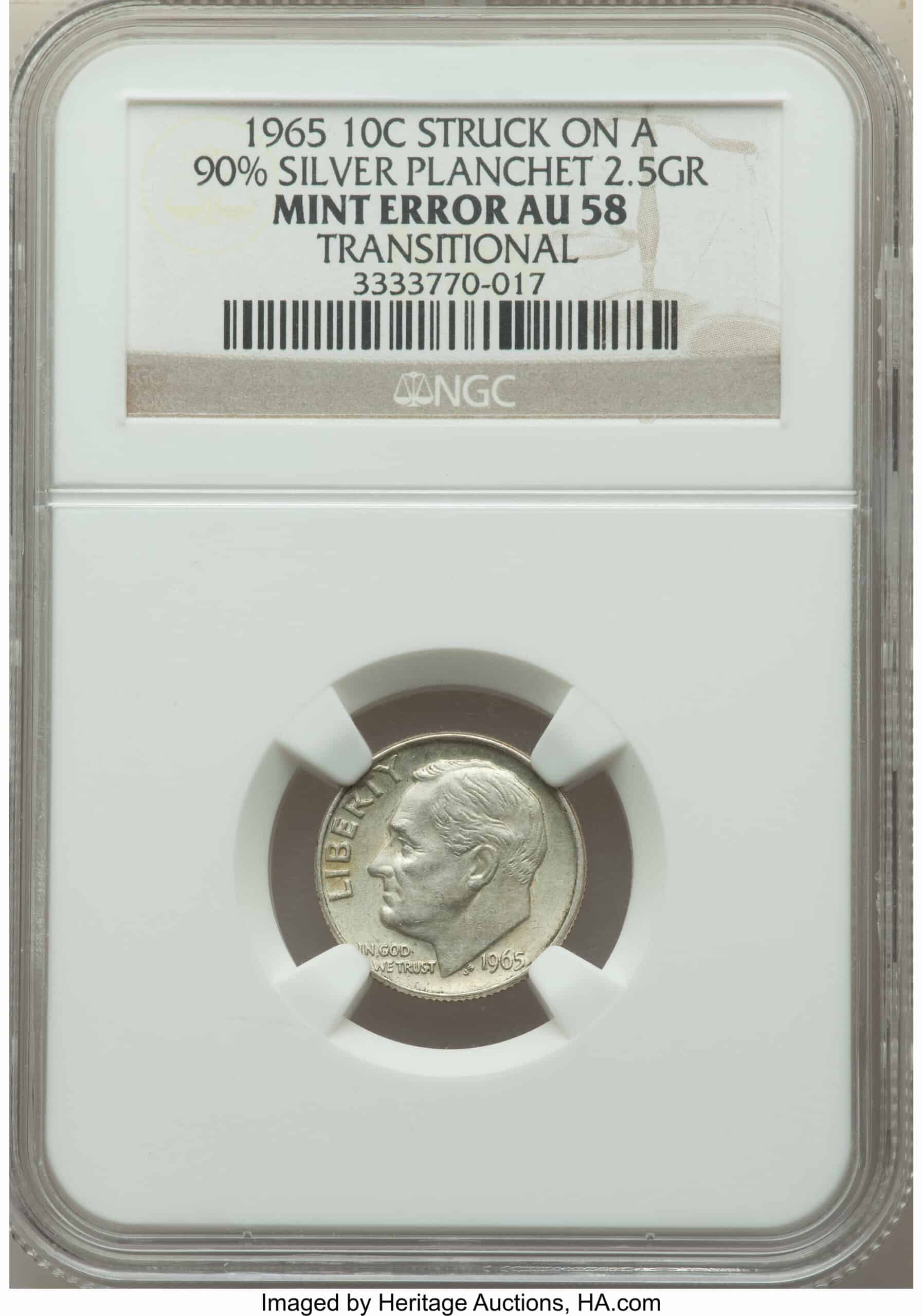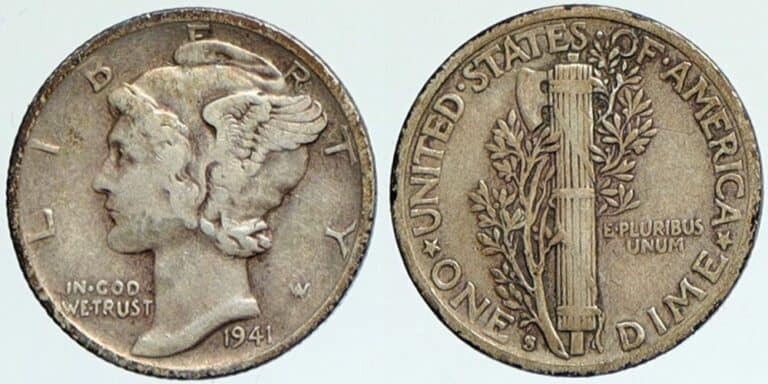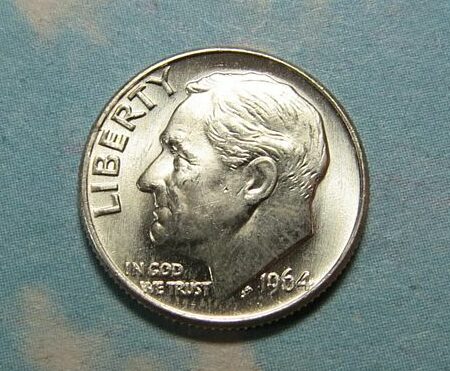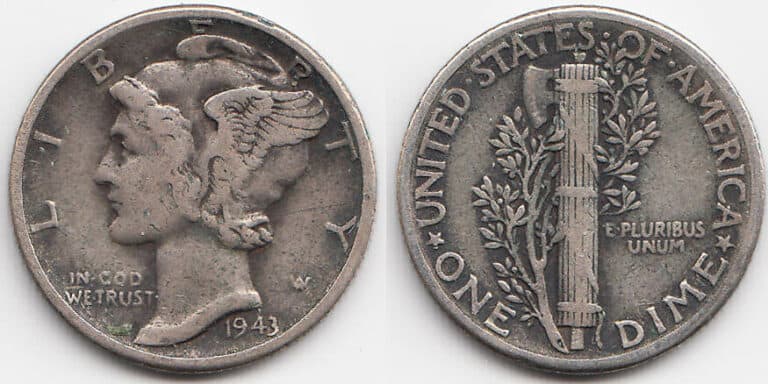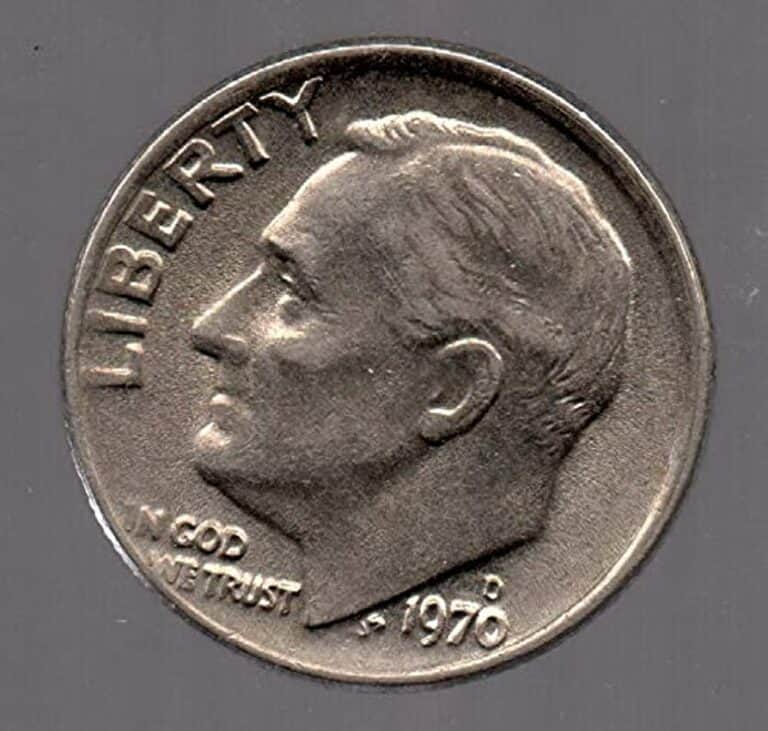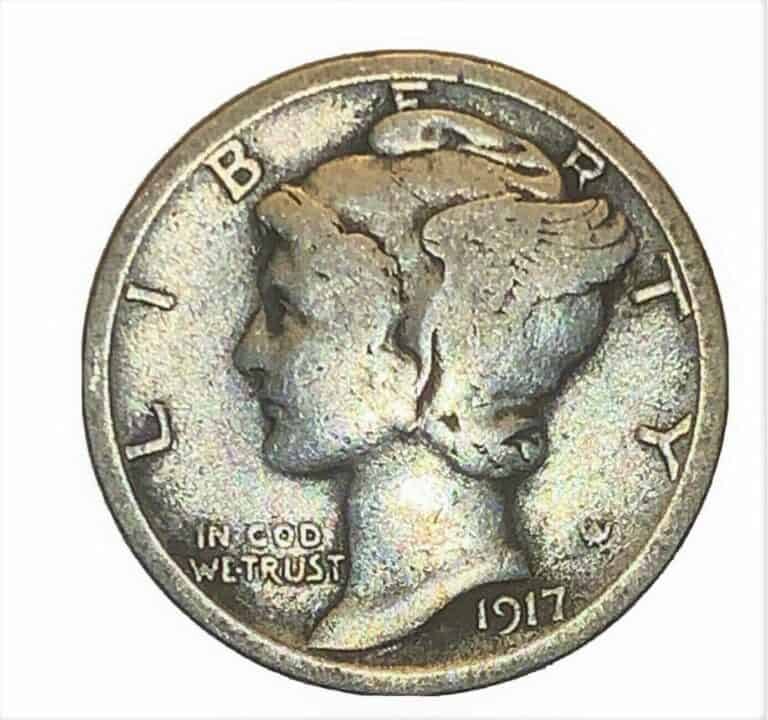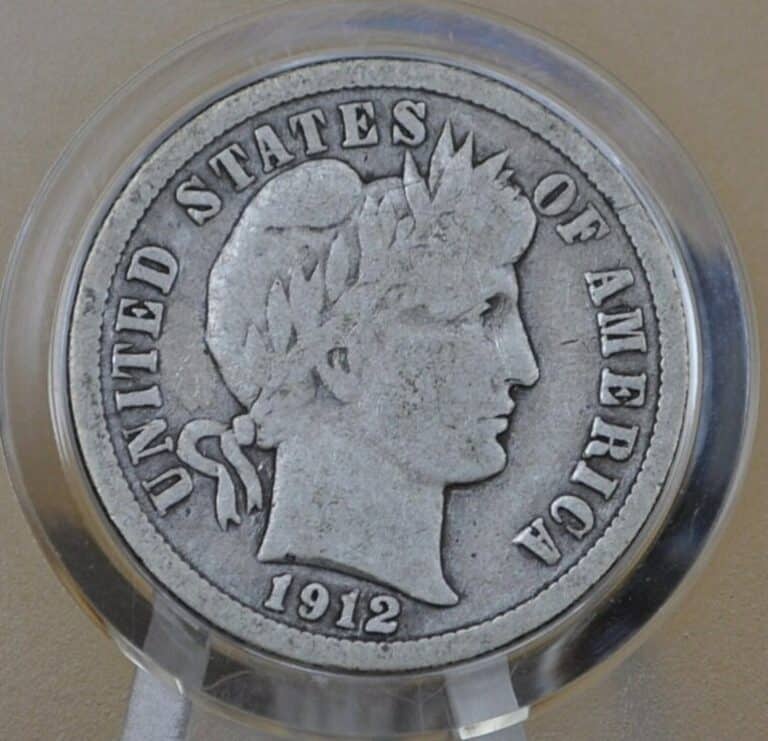1965 Dime Value: How Much Is It Worth Today?

Discovering the 1965 dime in your attic or change collection might be a way to cash out on thousands of dollars. Before you get too excited and go on a 1965 dime hunt, not all 1965 dimes are valuable.
Some 1965 dimes are made of silver, hence why they are worth so much. We bet you are curious about this coin now; keep reading to discover more.
1965 Dime Details
- Category: Roosevelt Dimes
- Mints: Philadelphia
- Total Mintage: 1,652,140,570
- Face Value: $0.10
- Observe Designer: John Sinnock
- Reverse Designer: John Sinnock
- Edge: Reeded
- Diameter: 17.9 mm
- Total Weight: 2.27g
- Composition: Copper-nickel
1965 Dime Value Chart
| Mint | Good | Fine | Extra Fine | Uncirculated |
| 1965 No Mint Mark Roosevelt Dime Value | $0.10 | $0.15 | $0.35 | $2.88 |
1965 No Mint Mark Roosevelt Dime
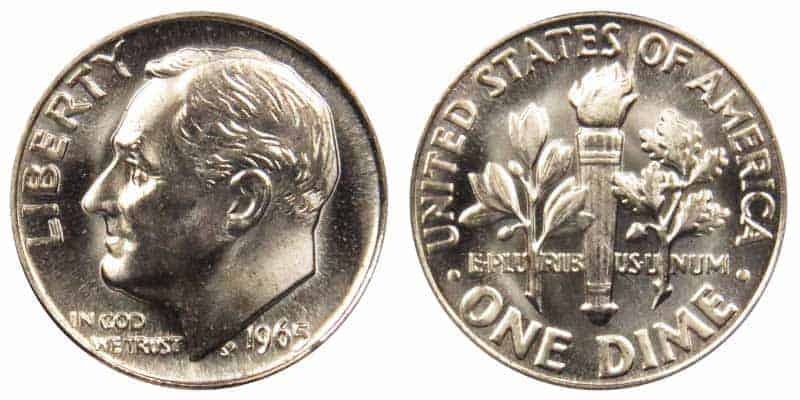
The 1965 dime was only minted in Philadelphia, hence there’s only one variation. It was produced in 1,652,140,570 instances, making it a very common coin. The majority of the 1965 dimes in circulation wouldn’t be worth more than their face value because they have been in circulation for a long time. But of course, to every rule, there’s an exception. If by luck, your 1965 – P dime is in mint state, it can be worth a lot more than its face value.
There’s no mint mark on the 1965 dime, as with other coins that have been produced in Philadelphia.
The coin was designed by John Sinnock, and the portrait on this coin is of President Franklin Roosevelt. A 1965 dime with a grade of MS66 is worth $26, according to PCGS, and that’s why your coin needs to be in excellent condition to be worth at least a sizeable amount.
However, if it’s graded MS68, you can sell it for $1,200 and maybe even more.
1965 Roosevelt Dime Full Band Value

Full-band coins have a deeper and more defined quality of strikes. The 1965 dimes categorized as “full band” are rare, and that’s because they were the first dimes to be minted on the fresh die. Ideally, the first set of coins minted from a new die has a higher and more precise strike, and the same goes for the 1965 dime.
According to PCGS, only 151 dimes from the 1965 mintage were detailed and delineated enough to be designated as a full band. As a result, their values are way higher than the regular 1965 dimes.
A 1965 dime graded at MS63 is worth about $3, while a full band designated variant is worth about five times more in that same grade. 1965 dimes graded at MS68 with full band designation is worth almost $4,000 or even more depending on market value.
In 2017, a full band designated MS69 graded 1965 dime was bought for $1,528 at an auction, and two years later, it was sold for twice that price.
1965 Roosevelt Special Strike Dime Value
During the 1965 mintage, special mint sets were produced for collectors and they all had every single denomination for the year.
The 1965 special mint sets aren’t proof sets, although they have a similar appearance to proof coins. These special strike sets have very high-quality strikes, and you can clearly see the details and design of the 1965 dime.
However, these special sets were minted in large quantities, thereby making them worth less than the regular 1965 dime.
At a grade of MS65, this special mint set is worth $7, and this value is lower than a regular 1965 dime with the same grading. Even when graded at MS68, its price doesn’t rise considerably, with $30, you can buy one.
These coins are mostly beneficial for their aesthetics because they can’t fetch you a fortune.
History of the 1965 Roosevelt Dime
The 1965 dime features the design of a torch, a sprig of an olive tree and oak on the reverse, while the observe depicts the image of President Franklin Roosevelt.
1965 was an interesting year because that was the first year the U.S. removed every trace of silver from its dimes. One of the major reasons for this decision was that individuals preferred to hold on to the dimes instead of spending them, as they were saving the dimes because of their silver content.
Also, it was becoming expensive to keep up with spending so much money on the production of silver dimes, as the production became more expensive than the face value of the dimes. For this reason, the U.S. mint decided to use solid copper clad in cupronickel alloy for its dimes. The resulting dimes had a very similar appearance to the previous dimes, and a similar weight as well.
Another interesting fact is that the 1965 dimes were struck in the three U.S mint facilities; Philadelphia, Denver, and San Francisco, but there was no way to differentiate because there was no mint mark. And it’s a known fact that coins minted in Philadelphia have no mint mark.
1965 Roosevelt Dime Grading
Grading your 1965 dime involves assessing the physical appearance to know the condition. If your 1965 dime is not an error coin, it has to be in perfect condition or mint state to have a premium value, or it’ll just be worth its face value.
When grading the 1965 Roosevelt dime, there are some points to note;
- Check for damages like scratches, spots, and discoloration, as this could reduce its value.
- Evaluate the coin’s strike; the design element should reflect the sharpness of the details in the coin. A 1965 dime with clear details is worth more than another with weak details.
- Take into consideration the overall appeal of the coin. Has it lost its shine? Is the color attractive? Answering this will certainly help in grading your coin.
Check out the video below to calculate the real value of your 1965 dime.
Rare 1965 Roosevelt Dime Error Lists
Errors are a “must” especially when coins are produced in large quantities. The 1965 dime was a “new dawn” and as such, it’s expected to have a few error coins. thankfully, errors increase the value of a coin drastically (depending on how unique).
Let’s see some interesting mistakes the U.S. mint produced during the mintage of the 1965 Roosevelt dime.
1. 1965 Dime Off-Center Error

This error happens only when the coin doesn’t align properly with the dies during striking, and it results in a completely off-center coin.
For the 1965 dimes that have this error, a large portion of the coin design was missing, and for some, it was shifted to one side. The degree of off-centeredness can vary, and this will obviously affect the price as well.
Off-center errors are highly desirable, especially if they are well-detailed and visually striking. It can fetch hundreds or thousands of dollars in an auction.
A 1965 dime in mint condition with the off-center error is worth about $100. As with any other coin, ensure you verify the authenticity of the coin before purchasing it.
2. 1965 Roosevelt Dime Cladding Error
The cladding error was a rare mistake that happened when the U.S. mint transitioned from producing coins with silver.
During the minting process, dimes were struck on blanks for other denominations, thereby resulting in a wrong composition. Some of the 1965 dimes didn’t have an observe at all, and some were not completely clad.
This error coin can be easily spotted as it usually has a different color and appearance from the regular 1965 dime.
A 1965 dime with the cladding error was sold for $90 during an auction. You can get a higher price value if the severity of the cladding error is well-defined.
3. 1965 Silver Error Dime
This is a very unique and highly sought-after error coin. The transitional error occurred when changing the composition of the dimes.
Accidentally, some 1965 dimes were struck on the silver planchets intended for the previous year – 1964.
Because this is a rare and unique error, the price of the error coin ranges from $3,000 to $6,000 depending on the condition of the coin. In 2019, a 1965 dime with the transitional metal error was bought for a whopping amount of $9,000.
4. 1965 Roosevelt Dime Broad Struck Error

The broad-struck error is not overly sought after one, but it still increases the value of your 1965 dime. This error happens the coin is struck without a collar die, resulting in a coin that has no edge reeding, hence making it a bit larger than normal dimes.
For the 1965 dime mintage, the coin was struck when the collar that was meant to hold the planchet in place wasn’t correctly aligned, and this resulted in a wider and thinner coin. Also, because the coin isn’t contained by the collar die, the coin’s design may appear elongated and distorted.
A 1965 dime with this error was bought at an auction for $80.
5. 1965 Roosevelt Dime Die Break Error
Die-break errors are only desirable by coin collectors when they are visually striking and very obvious. This error happens when the die used in striking the coin breaks or develops a crack, causing a fragmented design on the struck coin.
In the case of the 1965 dime, the die break caused a slight distortion just above the “LIBERTY” letters on the coin. However, because this error was not so glaring, it was bought for $20, but depending on the location and severity of the die break, it’ll be worth more than $20.
Curious about the errors of the 1965 dimes, watch the video below.
FAQs
1. Is The 1965 Dime Considered A Rare Coin?
Errors happen when there’s a transition in currency, and the 1965 mint did produce some 1965 silver dimes by mistake, thereby making it a rare coin.
Over 1 billion instances of the 1965 dime were minted in Philadelphia, hence it’s a very common coin. In reality, many of the 1965 dimes are still available today.
2. What Is The Value Of A 1965 Roosevelt Dime?
The value of the 1965 Roosevelt dime is dependent on its rarity and if it’s an error coin. A 1965 Roosevelt dime in an average circulated condition is worth its face value – $0.10, but in an uncirculated condition, it could be worth $10 or more.
3. What’s The Composition Of The 1965 Dime?
The 1965 dime is made up of 91.67% copper and 8.33% nickel.
4. Was The 1965 Dime Part Of The Silver Coinage?
No, it wasn’t. from 1965, the U.S. mint stopped the production of dimes with silver. It switched from using 90% of silver in its dimes to using a copper-nickel alloy.
5. What Dimes Are Worth A Premium Price After 1965 Dimes?
In average conditions, all dimes made after the 1965 dime rarely have more than face value, except in special instances (error coins). However, the dimes minted before 1965 have a premium price because they were made of 90% silver, therefore they are worth more than their face value.
6. Is 1965 Dime Made Of Real Silver?
No, all dimes produced after the 1964 dime are made of copper-nickel except for the 1965 silver error dimes.
7. How Can I Tell A 1965 Silver Dime?
It’s pretty easy to differentiate a silver 1965 dime from the regular one. The silver dime has a shinier look and weighs 2.5 grams, while the regular dimes weigh 2.27 grams.
8. Why Does The 1965 Dime Not Have A Mint Mark?
As with coins minted in Philadelphia, the 1965 dime doesn’t have a mint mark.
9. Where Can I Buy A 1965 Roosevelt Dime?
You can purchase a 1965 Roosevelt dime from marketplaces like eBay and Amazon, plus there are also other sites that specialize in buying and selling coins. however, make sure you are careful in your research, so you don’t buy a counterfeit 1965 dime.
Conclusion
Indeed, the 1965 Roosevelt coin may not be the rarest of coins, but it’s definitely a unique and significant coin. This dime was the first to be minted in copper-nickel instead of silver, and that was a turning point in U.S. coinage.
If by any chance you are lucky to discover the 1965 silver dime, then you have won the lottery. However, this will not be an easy feat because it’s an error coin and wasn’t minted in large quantities.
